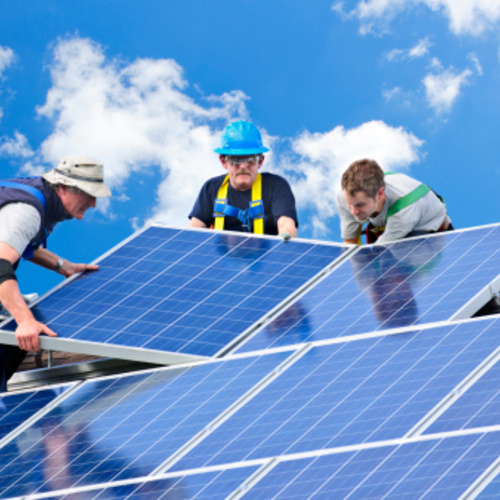
Image Credit: National Renewable Energy Laboratory / Billy Roberts
Many homeowners think of solar power as an improvement that might be cost-effective in the long term but prohibitively expensive in the short term. Even solar power, though, is susceptible to market forces, and right now those forces are pushing prices down in the U.S.
A New York Times story published on Thursday puts a perspective on PV system prices – which, the article notes, have dropped about 40% since the summer of 2008 – and the corresponding federal and state incentives designed to encourage homeowners to install renewable-energy systems.
There already are programs in place, including solar-buying collectives such as 1BOG, to help prospective PV system buyers land discounts. And some installers and municipalities – including Palm Desert, California, and Boulder County, Colorado – offer lease or finance options that allow homeowners to pay down the cost of their PV system through their property taxes or through the savings on their energy bills.
An expanding customer base?
But market equilibrium can be a wonderful thing, providing perhaps the most motivation yet for homeowners who had been on the fence about buying a system, even if federal and state incentives wind down as solar prices slip (check the Database of State Incentives for Renewables & Efficiency for updates on state, local, utility, and federal incentives and policies).
The Times piece cites one homeowner’s purchase of a 64-panel PV system for $77,000 (for a 7,000-sq.-ft. house in southeast Texas), which the owner says would have cost him $100,000 a year ago. He also will take a $23,000 tax credit and expects the system to trim 40% to 80% from his electric bill, which has been running $600 to $700 a month.
A lot of panels, the story adds, are coming from China, and the price drops, which are ongoing, are hurting many U.S.-based manufacturers. In the long term, however, manufacturers who manage to hang on could see a more robust and considerably expanded market for their products.
Weekly Newsletter
Get building science and energy efficiency advice, plus special offers, in your inbox.















4 Comments
Solar panel prices
The NYTimes article didn't make it clear whether the cost of solar cells has come down, or whether the cost of entire systems has come down (including inverters, etc.). Nor are we told what the capacity of the system is in kW, so we can't know what the cost per installed watt is. The numbers have limited usefulness. I wondered what the source of the information was also.
Modules, not inverters
Scott,
The price of PV modules has come down in the last year, although not quite as much as the Times article suggests. I don't think there has been any significant drop in the cost of inverters, racks, cable, or installation labor.
My first PV module cost me $8.33 per watt in 1980. I paid $3.97 per watt in 2004, and $3.99 per watt in April 2009. Current PV module prices can be as low as $3 a watt, but only if you buy a whole pallet of modules. Otherwise you're still liable to pay $3.50 to $3.96 a watt.
I think that's the price of cells in wholesale market
I think the NY times has the change in wholesale price of cells, or maybe even spot market price for raw material, and it is probably a rounded up number too. From my recollection of the price of some of the panels I bought in early 2007 the price of same panel is down about 25%m certainly not more than 30%.
The price of inverters hasn't really changed. The price of labor hasn't either. I would expect an installed system to be down about 15% in two / nearly 3 years. Indeed since I know local installers' price per watt installed, that is exactly the case.
I suspect the McMansion owner in the article (7000sq ft) was quoted an uncompetitive price last year.
I've seen people get quoted $12 per installed watt, and seriously consider it (until they spoke to me), when the competitive price is closer to half that.
For installers, getting
For installers, getting around the ROI issue with potential customers (even with large state and federal incentives that currently drop the installed price to less than half what they would cost without incentives) is the biggest stumbling block. For example, in NH, a $19,000 2.x kW system would only end up costing the buyer about $7,400 after the 30% federal tax credit and the $6,000 NH state PUC rebate (yes, REBATE), yet customers still bock at the cost. Payback period is 10-12 years. After that it's all money in your pocket, yet people don't see it that way. What would it take to get folks to get on board? Why are homeowners willing to plunk down twice this amount for kitchen and bath remodels? Is it time to deliver the HGTV audience a dose of "sexy" renewable energy shows similar to the barrage of remodeling shows that currently clog the airwaves or is that "selling out?" Perhaps folks still see PV as "alternative" energy rather than something that can become mainstream.
Log in or create an account to post a comment.
Sign up Log in